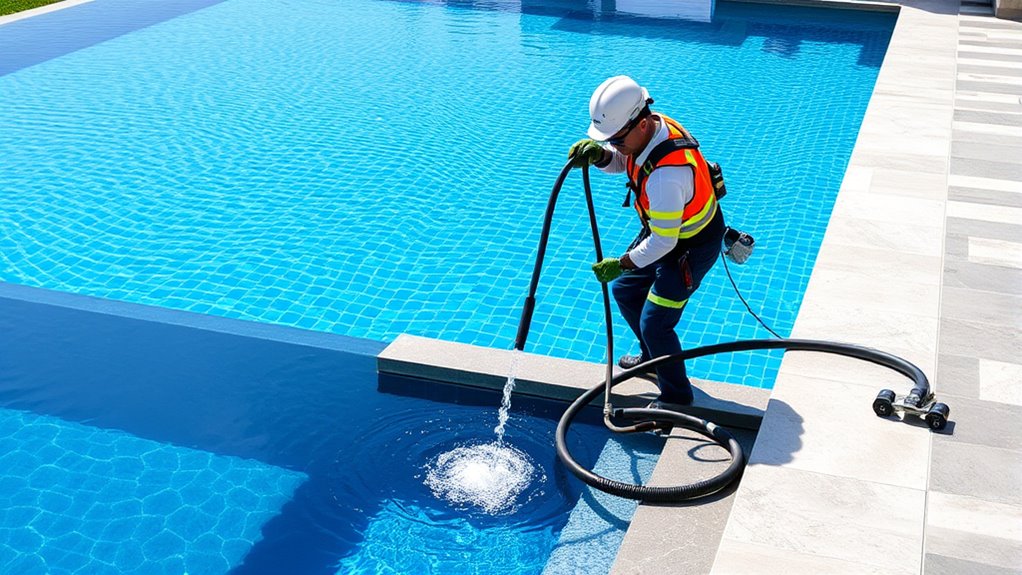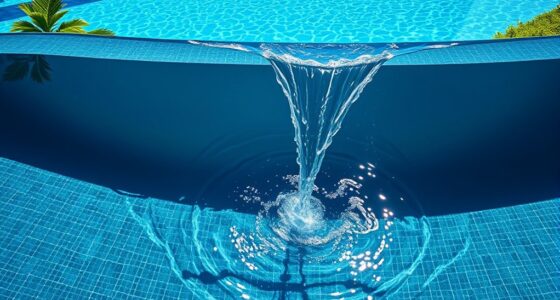To safely drain your infinity pool system, start by gathering all necessary tools and inspecting the equipment for damage or leaks. Turn off the power and main pumps, then carefully drain the water, ensuring spillways and water features are emptied completely. Flush the plumbing lines to prevent debris buildup, and inspect for cracks or leaks. Protect and cover your pool during off-season storage. If you continue, you’ll learn more detailed steps to complete the process securely.
Key Takeaways
- Turn off the main power and filtration system before beginning drainage to prevent electrical hazards.
- Use proper tools and secure hoses to safely direct water away from the pool and surrounding areas.
- Drain water gradually from the overflow and skimmer lines, monitoring for leaks or blockages.
- Inspect and clean plumbing components and equipment for damage prior to draining fully.
- Cover the pool with a weather-resistant cover after draining to protect it during inactivity.
Gather Necessary Tools and Equipment

Before you begin draining your infinity pool, it’s essential to gather all the necessary tools and equipment. You’ll need a submersible pump or a garden hose with a siphon attachment to remove the water efficiently. Make sure you have sturdy gloves and safety goggles to protect yourself from splashes or debris. A utility knife or hose connectors might come in handy if you need to modify hoses or create secure connections. Additionally, keep a bucket or container nearby for collecting residual water. Check that your pump has enough capacity for your pool size. Having these tools ready guarantees the draining process goes smoothly and safely, preventing delays or accidents. Being prepared helps you avoid unnecessary trips back to the toolbox during the task. Proper organization of your tools ensures a quicker and safer draining process.
Turn Off the Pool’s Power and Pumps

Turning off the pool’s power and pumps is a crucial step to guarantee safety and prevent damage during the draining process. Before you start, locate your pool’s circuit breaker and switch off the power supply. This stops electrical components from running and reduces the risk of electric shock. Next, turn off the pool’s main pump and filtration system. Running the pump during draining can cause damage or create a safety hazard. Make sure all controls are switched off and unplugged if necessary. Confirm that no power is flowing to the system before proceeding. By doing this, you protect yourself from electrical hazards and avoid damaging the pool’s equipment. Ensuring the power and pumps are off creates a safe environment to begin draining your infinity pool.
Drain the Main Pool Water Carefully
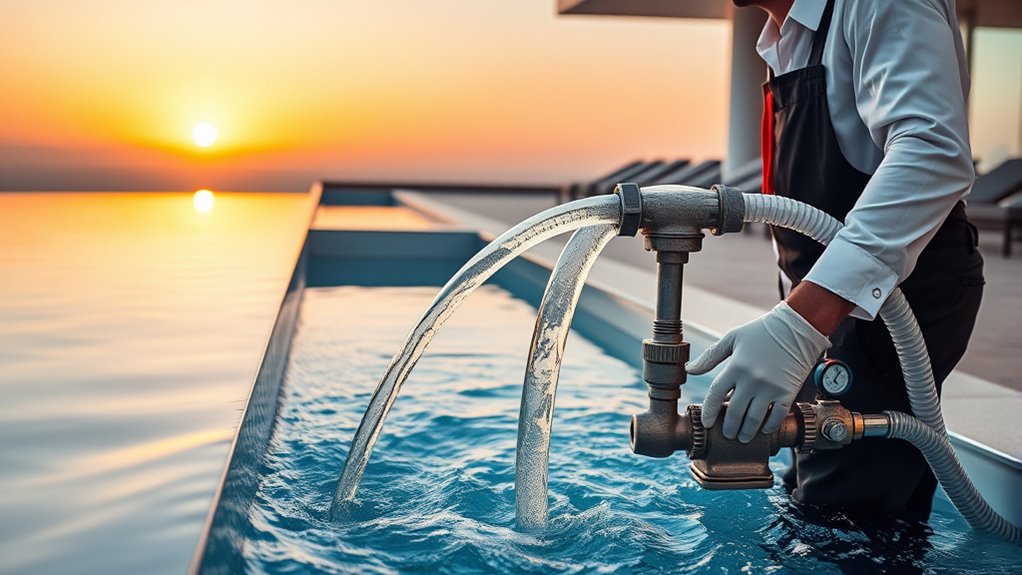
Carefully draining the main pool water is essential to prevent overflowing or damaging surrounding areas. Begin by positioning your sump pump or submersible pump at the deepest part of the pool. Connect the hose securely to ensure a steady flow and avoid leaks. Monitor the water level constantly to prevent the pool from draining too quickly, which could cause structural stress. If your pool has a main drain, use it carefully, ensuring it’s free of debris to allow smooth water flow. Keep an eye on the drainage rate to prevent sudden surges that might crack the pool shell. Once the water level drops to the recommended point, turn off the pump and disconnect everything safely. Properly managing this process protects both your pool and its surroundings. Additionally, using proper safety precautions can help prevent accidents during the draining procedure.
Empty the Water Features and Spillways

Before draining your water features and spillways, make sure to turn off all pool equipment to prevent damage. Then, carefully drain the water to avoid leaks or spills. Finally, remove spillway components to allow complete emptying and safe maintenance. Proper drainage practices are essential to ensure the longevity of your water features and promote sustainable maintenance routines.
Turn Off Pool Equipment
To prevent damage during draining, start by turning off your pool equipment completely. This includes the pump, filter, and any auxiliary systems. Turning off equipment ensures no power runs through the system, reducing the risk of electrical issues or damage as water levels change. Before draining, also disconnect any automation controls to prevent malfunction. Use the table below to identify which parts to turn off and disconnect:
| Equipment | Action |
|---|---|
| Pool Pump | Switch off and unplug |
| Water Features | Turn off and disconnect hoses |
| Spillways | Shut valves or disconnect lines |
Additionally, understanding city dynamics can help anticipate potential challenges during maintenance or repairs.
Drain Water Safely
Since water features and spillways are connected to your pool system, draining them properly is essential to prevent possible damage. To do this safely, follow these steps:
- Turn off the pump and any related equipment to stop water flow.
- Use a submersible pump or siphon to remove water from the features and spillways.
- Open drain valves or outlets to allow gravity to assist in emptying the water.
- Regularly inspect your whole-house filtration system to ensure debris does not clog drainage pathways or cause system damage.
Ensure you wear protective gloves and goggles during the process. Avoid using high-pressure hoses that could damage delicate components. By carefully draining these connected features, you prevent pressure buildup, freeze damage, or leaks. Properly removing water from water features and spillways keeps your system in top shape and prepares it for seasonal shutdown or maintenance.
Remove Spillway Components
Removing spillway components is a crucial step to guarantee your water features are properly drained and protected from damage. Start by turning off the power to the spillway pump and system. Carefully disconnect any hoses or fittings connected to the spillway. Remove the spillway cover or grate, ensuring you keep track of all parts. Check for any remaining water inside the spillway or water features, and drain it completely using a wet/dry vacuum or a siphon if needed. This prevents water from freezing and causing cracks during colder months. Additionally, a thorough drainage process can help maintain system efficiency and prolong the lifespan of your water features. Once empty, store spillway components in a safe, dry place. Proper removal and storage protect your water features from damage and make reassembly easier when you’re ready to restart your pool.
Remove and Store Pool Accessories and Equipment

Before draining your infinity pool, make sure to remove all accessories and equipment to prevent damage or loss. This step protects your investment and keeps everything organized for reassembly. Start by removing items such as pool brushes, skimmers, and vacuums. Next, carefully store delicate equipment—like timers or sensors—in a safe, dry location. Finally, take out any floating toys or decorative items that could be damaged or cause blockages during the draining process.
Always remove accessories and delicate equipment before draining your infinity pool to prevent damage and ensure proper reassembly.
- Remove and store pool cleaning tools and skimmers.
- Safely store electronic components and sensors.
- Collect floating accessories and decorative items.
Drain the Overflow and Skimmer Lines

Before draining the overflow and skimmer lines, make sure you have the right drainage equipment ready. Carefully remove any remaining water from these lines to prevent damage or mess. Taking these steps guarantees a safe and efficient process as you prepare for the pool drain. Recognizing the angel numbers associated with transitions can also serve as a reminder to stay alert during this process.
Prepare Drainage Equipment
To guarantee a safe and effective drainage process, you need to prepare the overflow and skimmer lines properly. Start by gathering the necessary equipment, such as hoses, plugs, and wrenches, to ensure smooth operation. Next, inspect all lines for damage or blockages that could hinder drainage. Finally, secure the connections and ensure the hoses fit tightly to prevent leaks. Additionally, recognizing signs like patterns in angel numbers can help you stay alert to any unusual occurrences during the process. Here are three key steps to prepare your drainage equipment: 1. Gather all tools and replacement plugs needed for the process. 2. Check for any cracks, leaks, or debris in the overflow and skimmer lines. 3. Tighten fittings and connections to avoid water loss during drainage. Proper prep minimizes risks and keeps the process efficient and safe.
Remove Water Safely
With your drainage equipment prepared and connections secured, you can now begin removing water from the overflow and skimmer lines. Start by opening the valves controlling these lines to allow water to flow out. Use your pump or vacuum system to gently draw water from the overflow drain, ensuring you don’t create pressure that could damage the pipes. Next, carefully open the skimmer line valves, letting water drain into your collection container or designated drainage area. Keep an eye on the flow to prevent splashing or spills. Once the water levels drop sufficiently, close the valves securely. Properly draining all lines is essential for maintaining your pool system’s WWE Raw’s Financial Impact, preventing residual water from freezing or causing damage during colder months, ensuring your pool system is properly prepared for winter or maintenance.
Clear and Flush the Pool Plumbing System

Ensuring your pool plumbing system is clear and free of debris is essential for a safe drain. If debris clogs the lines, it can cause damage or prevent proper draining. Start by turning off the pool pump and opening the drain plugs. Then, follow these steps:
- Flush the lines with clean water to remove dirt and debris trapped inside.
- Use a garden hose or a specialized flushing tool to force water through the pipes, guaranteeing they are clear.
- Check for blockages by listening for unusual sounds or resistance when flushing.
- Regular maintenance and proper system design can help prevent buildup and ensure optimal performance.
Inspect for Potential Damage or Leaks
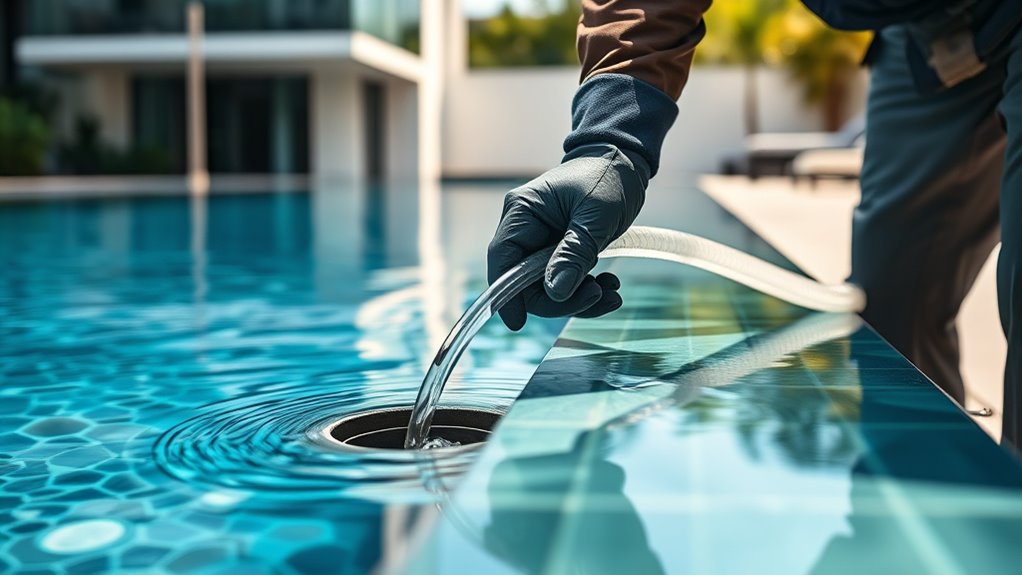
Before draining your infinity pool, it’s important to carefully inspect the system for any signs of damage or leaks. Check around the pump, filters, and plumbing connections for cracks, corrosion, or wet spots. Look for drips or pooling water that could indicate a leak. Pay special attention to the seams and joints, as these are common failure points. If you notice any damage or suspect a leak, address it before proceeding with the drain. Small cracks or leaks can worsen during draining, leading to costly repairs. Use a flashlight to spot hidden leaks or damage. Ensuring the pool’s integrity now prevents bigger issues later and guarantees a safer, more effective drainage process.
Properly Store or Cover the Pool During Off-Season
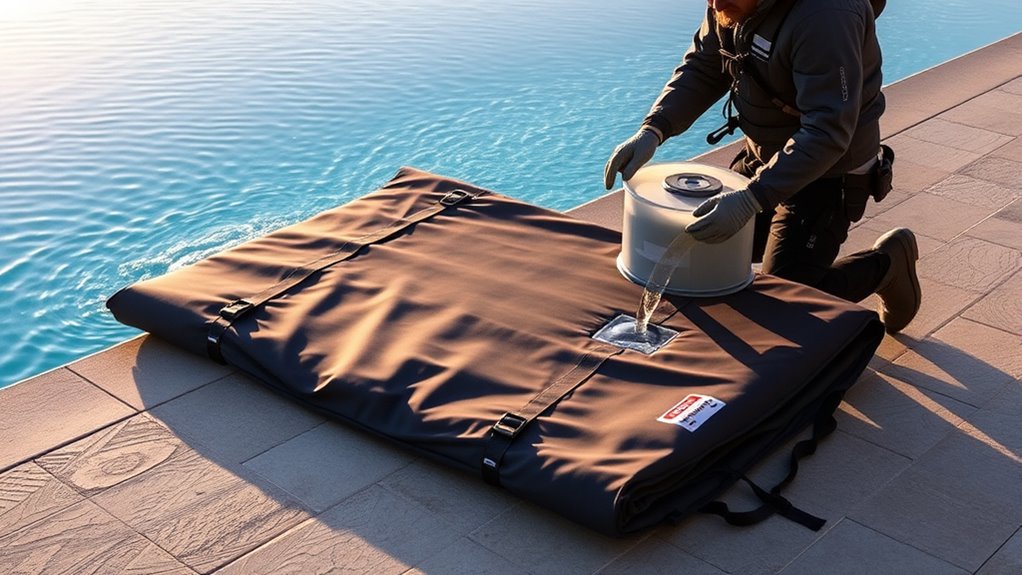
When the swimming season ends, it’s vital to properly store or cover your infinity pool to protect it from the elements and prevent damage. A well-chosen cover keeps debris out, shields against harsh weather, and reduces wear on your pool’s surface. To guarantee your pool stays in top condition, consider these steps:
- Clean the pool thoroughly, removing dirt, leaves, and algae.
- Drain all water from the system to prevent freezing and cracking.
- Use a durable, weather-resistant cover that fits snugly to prevent debris from entering.
Refill the Pool Safely When Ready to Use

When you’re ready to refill your pool, start by checking the water levels to make they’re appropriate. Use proper filling techniques to prevent overflows or damage, and then carefully monitor the chemical balance as you add water. This way, you’ll keep your infinity pool safe, clean, and ready for enjoyable use.
Check Water Levels
Have you checked the water level recently to make certain your pool is ready for use? Ensuring proper water levels is vital for safe operation and to prevent damage. First, confirm that the water is at the manufacturer’s recommended level—usually halfway up the skimmer opening. Second, inspect the water for clarity and chemical balance to avoid issues like algae growth or corrosion. Third, monitor for any signs of leaks or unusual drops in water level, which could indicate a problem needing attention. Maintaining accurate water levels helps your infinity pool function correctly and extends its lifespan. Regular checks before use will ensure you enjoy a safe, hassle-free swimming experience.
Use Proper Filling Techniques
To refill your infinity pool safely, start by using a garden hose or appropriate water source that delivers a steady flow. Avoid high-pressure outlets that could cause splashing or uneven filling. Fill slowly to prevent stress on the pool structure and equipment. Use a reliable water source to ensure clarity and quality. Monitor the water level regularly to prevent overfilling or underfilling. Here’s a breakdown to help you stay on track:
| Step | Key Point | Why It Matters |
|---|---|---|
| Use a steady water source | Prevents uneven filling | Protects pool integrity |
| Fill slowly | Avoids stress on the structure | Ensures even water distribution |
| Regular monitoring | Maintains proper water level | Prevents damage or overflow |
| Quality water source | Ensures clean, safe water | Protects your investment |
Monitor Chemical Balance
Once you’ve finished refilling your pool, it’s important to check and adjust the chemical balance before use. Proper chemical levels ensure safe, clean swimming and protect your pool equipment. Start by testing the pH, alkalinity, and sanitizer levels with a reliable kit.
To maintain ideal balance:
- Adjust the pH to between 7.2 and 7.6 to prevent skin irritation and equipment damage.
- Ensure alkalinity levels are between 80-120 ppm to stabilize pH and prevent fluctuations.
- Add the appropriate amount of sanitizer, like chlorine or bromine, to eliminate bacteria and algae.
Regular testing and adjustments keep your pool safe, comfortable, and ready for use whenever you want to swim.
Frequently Asked Questions
How Do I Prevent Algae Growth During the Draining Process?
To prevent algae growth during draining, you should first thoroughly clean the pool and balance the water chemistry. Then, add an algaecide to inhibit algae spores. Keep the pump running to circulate chemicals, and cover the pool with a tight-fitting cover when not working on it. This prevents debris and spores from entering, reducing algae growth during the draining process. Regular monitoring and maintenance are key for a clean, algae-free pool.
What Safety Precautions Should I Take When Handling Pool Chemicals?
You should always wear protective gear like gloves and goggles when handling pool chemicals to prevent skin and eye irritation. Work in a well-ventilated area to avoid inhaling fumes. Read and follow the instructions on each chemical’s label carefully. Never mix different chemicals, as this can cause dangerous reactions. Store chemicals securely away from children and pets, and wash your hands thoroughly after handling them.
Can I Drain My Infinity Pool Alone or Should I Hire a Professional?
You can drain your infinity pool alone, but it’s not recommended. A coincidence might be that you’re experienced with pool maintenance, yet draining a large system involves risks like equipment damage or injury. Hiring a professional guarantees proper procedures, safety, and peace of mind. They have the right tools and expertise to handle the job efficiently, preventing costly mistakes and keeping you safe throughout the process.
How Long Does the Entire Draining and Refilling Process Typically Take?
It usually takes about 8 to 12 hours to fully drain and refill your infinity pool, depending on its size and your water pressure. If you’re doing it yourself, plan for extra time to guarantee the process completes safely. Be patient and monitor the levels closely. Hiring a professional can speed things up and reduce risks, especially if you’re unfamiliar with pool systems.
What Are Common Signs of Damage to Look for After Draining?
After draining your infinity pool, look for cracks or chips in the tile or concrete, which indicate damage. Check the pool’s structure for any bulges or shifts, as these can signal issues. Also, inspect the filtration system for leaks or corrosion, and guarantee no debris is lodged in the jets or drains. Regularly monitoring these signs helps prevent costly repairs and keeps your pool in top condition.
Conclusion
Draining your infinity pool safely keeps it protected through the off-season, much like a well-guarded treasure. While the process might seem straightforward, neglecting proper steps can lead to costly damage or leaks. Think of it as a delicate dance—precision matters. When done right, you’ll enjoy a pristine, worry-free pool ready for the season ahead. Protect your investment, and your pool will reward you with years of stunning, seamless beauty.
